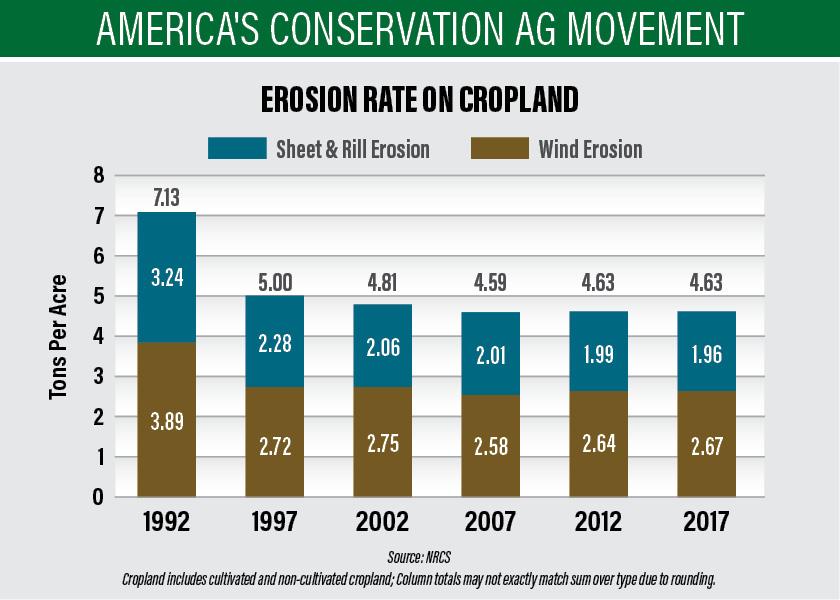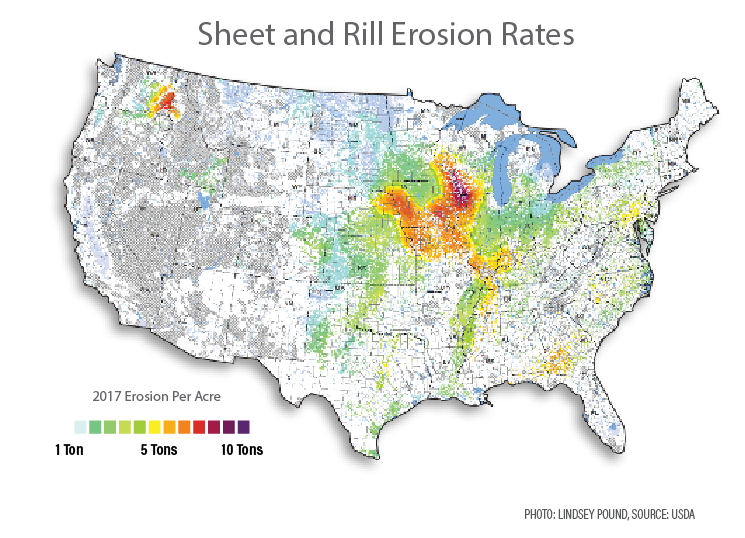Soil Erosion Trends in the U.S.

Oceanfront property wasn’t on Brian Scott’s wish list when he bought a rental farm in 2017 that included 9 acres of sandy soils fit for a south-Florida beach.
Scott tried to grow corn and soybeans across the entire farm while renting it. But the sandy ground, featuring a small, steep hill prone to erosion, wouldn’t cooperate.
“We’d go up there and drag all our equipment around, put all the inputs in and then basically not harvest anything,” recalls Scott, who grows 2,200 acres of corn and soybeans near Monticello, Ind. “We quit farming it when we purchased it.”

Scott seeded the sandy patch of soil to a prescribed pollinator mix this past spring, thanks to financial and project support from his local Natural Resources Conservation Service (NRCS) office and Farm Service Agency. He also is enrolled in the Conservation Reserve Program (CRP).
“Between the cost-share payment for establishment and annual CRP payments going forward, we figure by the third year we’ll make a little money,” he says.
![]()
In the process, Scott says the pollinator mix – which includes 24 different plant species – is helping him reduce erosion and hold soils in place.
A Strategy To Go Small
Scott’s decision to address erosion in a small, targeted area is one NRCS National Agronomist Betsy Dierberger would like to see other farmers emulate.
“Applying more and more conservation practices on a whole field may or may not hit the right amount of erosion control for those specific areas in fields that need a little bit more precise care and planning,” Dierberger explains. “There may be spots that are more vulnerable to erosion by wind or water or because of their location topographically, or it might be the field’s soil properties that increase the vulnerability in certain spots.”

Erosion rates computed from NRI data are estimates of average annual (or expected) rates based upon long-term climate data, inherent soil and site characteristics, and cropping and management practices.
Despite improvements, erosion is still a huge concern for farmers, notes crop consultant James Hoorman, owner of Hoorman Crop Health Services, based in Hancock County, Ohio.
“It’s not the 20-ton per acre average losses we saw during the Dust Bowl in the 1930s, but it’s still too high and unsustainable,” he says.
Soils Struggle to Keep Up
The NRI report shows water (sheet and rill) erosion rates averaged 2.67 tons per acre in 2017, and the erosion rate due to wind averaged 1.96 tons per acre.
“I often ask the question, are we conserving our soil resources, or are we mining them?” Hoorman says.
At best, soils can only regenerate about a half ton per acre per year, he estimates. The regeneration process is slow.
“Rock breaks down into sand, sand breaks down into silt, and then silt breaks down into clay,” he says.
While soil erosion can be visually dramatic, such as obscured roadways from blowing dust, that’s not always the case. Scott says erosion is difficult to see on some of his fields. Nonetheless, he is proactive to ad-dress it by no-tilling all crop ground and slowly adding cover crops.
“We have about a quarter of the farm in cover crops now, starting back in 2012, and that certainly helps,” he says.
Along with that, wherever water erosion is a concern, Scott has installed 40’ CRP grass buffer strips.
“We know there's a lot of nutrients and productivity and all other kinds of good stuff in our topsoil, and we want to keep it where it is,” Scott says.
Technology Can Help
Dierberger says NRCS erosion estimation tools for both wind and water erosion, along with soil vulnerability indexes, can estimate the degree of erosion present in a field.
These Agricultural Research Service-supported tools, along with soil vulnerability index maps, help planners and farmers to quickly identify sensitive areas on farming operations and then decide if crops, field operations, and management changes can lead to reduced erosion.
“We can assess the current state of erosion for that field and then look at the results, and the farmer can decide whether to tweak the crop rotation or the intensity of tillage or type of tillage,” she says. “We want to help the producer think about how to keep more residue – whether it’s alive or dead – on the field to keep those soils covered.”
Organic matter is the glue that binds soil together and keeps it in place, according to the Noble Research Institute. The Institute’s research suggests that “increasing soil organic matter from 1% to 3% can reduce erosion between 20% and 33%, because it increases the soil’s water-holding capacity.”
Building soil organic matter takes time and intentionality, and sometimes – despite farmers’ best intentions – Mother Nature interferes. Dierberger says NRCS can adjust to help farmers with their conservation plans, even then.
“We can adapt and be flexible in helping farmers when their plans change,” she says. “We will work with you to make sure you get the conservation benefits you signed up for by adjusting your conservation plan implementation. We understand things happen beyond your control.”
How Soil Health Changes The Conversation
Profiting from Carbon and Soil Health
Crop Inputs And Soil Health: How Do They Interact?







